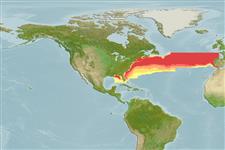Common names from other countries
Environment: milieu / climate zone / depth range / distribution range
Ecologia
marinhas. Temperate; 48°N - 24°N, 89°W - 5°W
Western Atlantic: Nova Scotia in Canada to southern Florida in USA and eastern Gulf of Mexico (Ref. 7251). Eastern Atlantic: juveniles occasionally accompany floating objects across the Atlantic and have been recorded from Ireland, around the British Isles, off Portugal and the western Mediterranean.
Tamanho / Peso / Idade
Maturity: Lm ? range ? - ? cm
Max length : 91.0 cm TL macho/indeterminado; (Ref. 7251); common length : 30.0 cm SL macho/indeterminado; (Ref. 4542); peso máx. publicado: 12.3 kg (Ref. 7251)
Lives in deep water over continental slopes. Adults in submarine canyons, young more widely found in surface layers and may occur at times close inshore docks. Young to 30 cm common in large groups during summer and autumn under floating boards, boxes and barrels. Does not associate with medusae. Adults probably schooling in depths but not on the bottom. Feed on small fishes and crustaceans; also sqiud and molluscs (Ref. 5951). Probably a spring spawner. (see Ref 4542).
Ciclo de vida ou comportamento de acasalamento
Maturities | Reprodução | Spawnings | Egg(s) | Fecundities | Larvas
Bauchot, M.-L., 1987. Poissons osseux. p. 891-1421. In W. Fischer, M.L. Bauchot and M. Schneider (eds.) Fiches FAO d'identification pour les besoins de la pêche. (rev. 1). Méditerranée et mer Noire. Zone de pêche 37. Vol. II. Commission des Communautés Européennes and FAO, Rome. (Ref. 3397)
Status na Lista Vermelha da UICN (Ref. 130435)
CITES (Ref. 128078)
Not Evaluated
Ameaça para os humanos
Harmless
Uso pelos humanos
Pescarias: pouco comercial
Ferramentas
Relatórios especiais
Baixar XML
Fontes da internet
Estimates based on models
Preferred temperature (Ref.
115969): 5.7 - 19.7, mean 11.6 (based on 85 cells).
Índice de diversidade filogenética (Ref.
82804): PD
50 = 0.5156 [Uniqueness, from 0.5 = low to 2.0 = high].
Bayesian length-weight: a=0.00891 (0.00406 - 0.01955), b=3.10 (2.91 - 3.29), in cm Total Length, based on LWR estimates for this (Sub)family-body shape (Ref.
93245).
Nível Trófico (Ref.
69278): 3.9 ±0.55 se; based on food items.
Resiliência (Ref.
120179): Baixo, tempo mínimo de duplicação da população 4,5 - 14 anos (Preliminary K or Fecundity.).
Fishing Vulnerability (Ref.
59153): High vulnerability (56 of 100).
